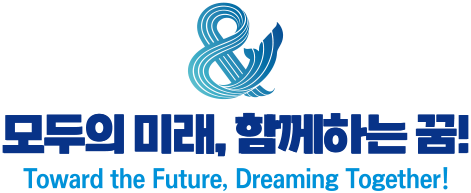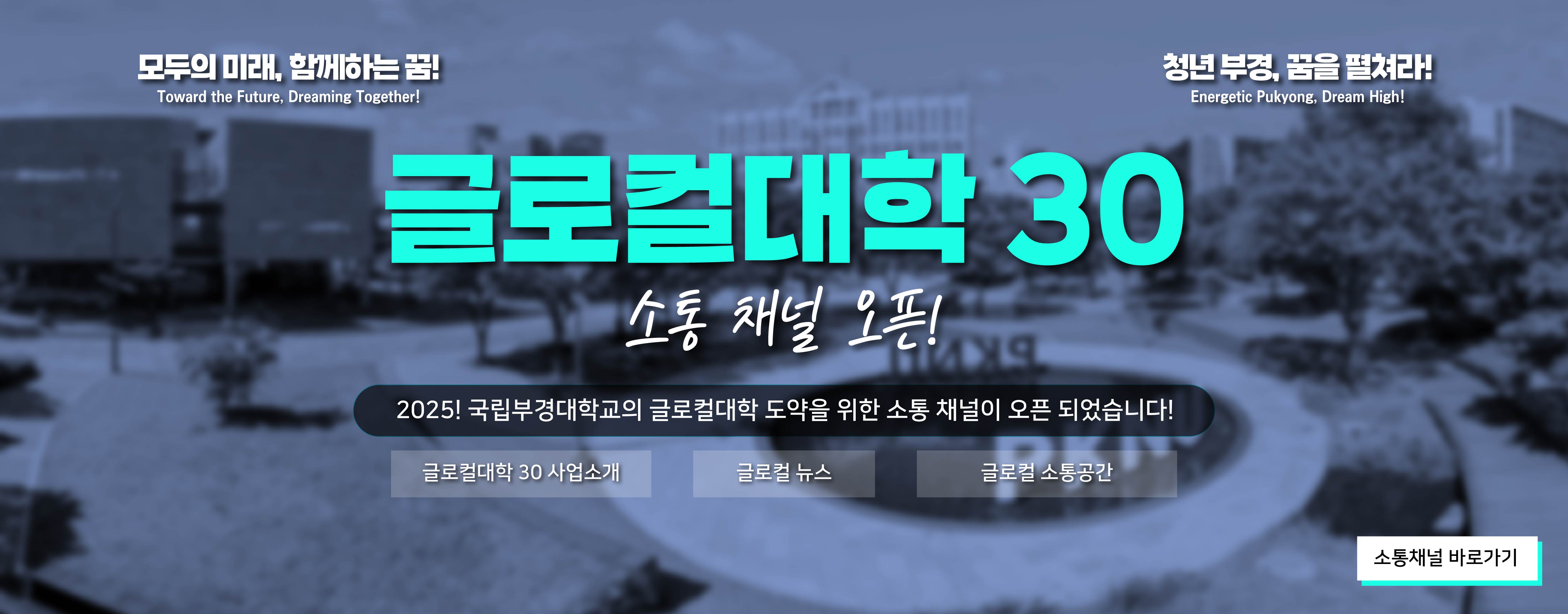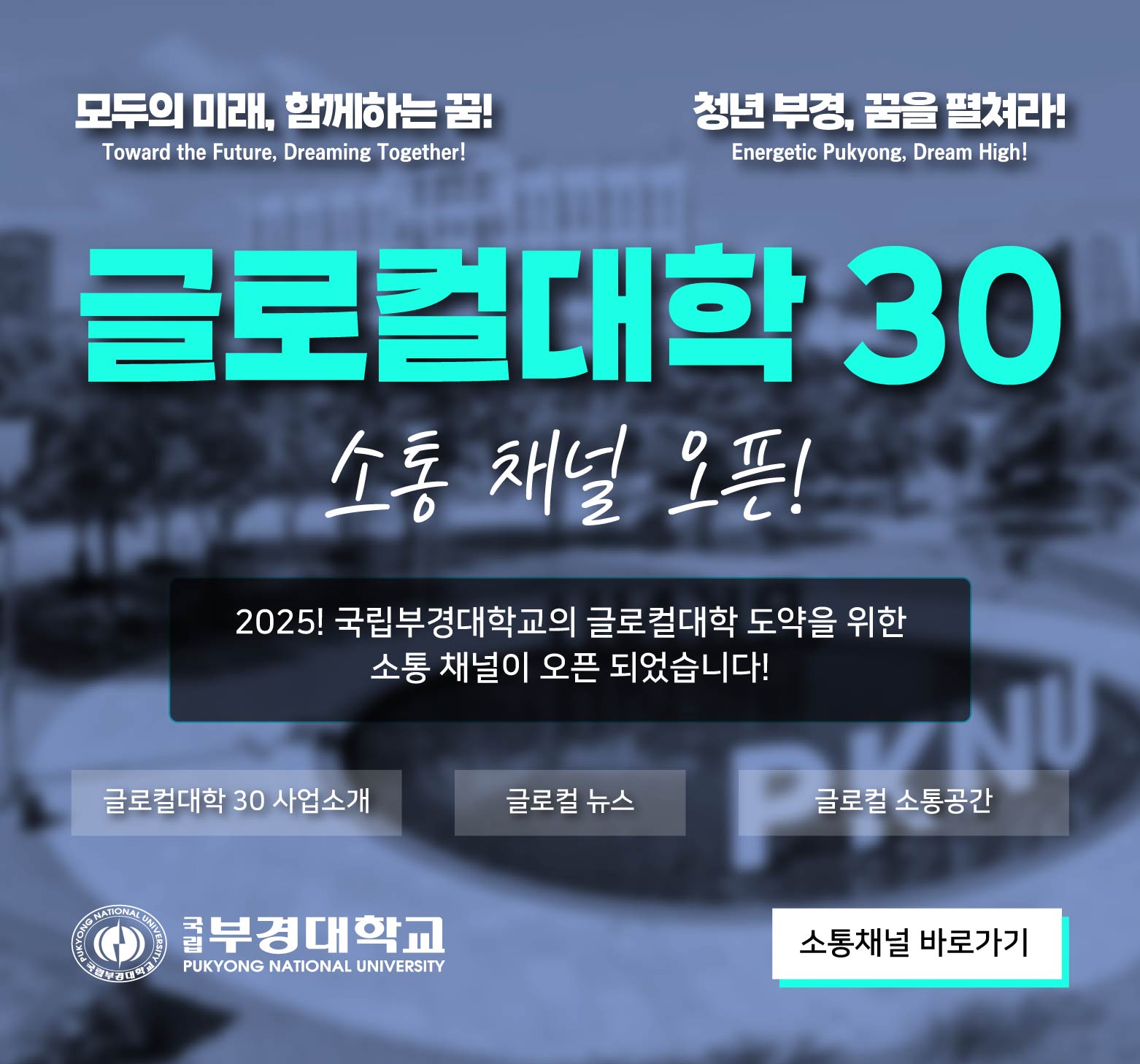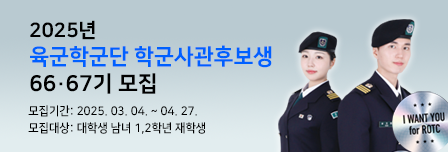
-
★2025년도 한미 첨단분야 청년교류 지원사업 "예비 장학생" 선발 안내★
2025-04-04 -
♥(활동비 30만원 지급) 2학기 이공계 엘리트 여학생을 모집합니다!♥
2025-04-03 -
2025-2학기 중어권 파견 교환학생 프로그램 추가선발 참가자 모집
2025-04-03 -
★☆부산광역시 박형준 시장 특강 개최 안내☆★
2025-03-31 -
대학 중장기발전계획 수립을 위한 설문조사 참여 안내
2025-03-31 -
2025학년도 상반기 국제학생증(ISIC)발급비 지원 행사 안내
2025-04-04 -
★(100만원 지원) 기업연계 여대생 팀프로젝트 지원사업 모집★
2025-04-03
-
◈ [이차전지특성화대학지원사업] Open Lab Day 참여 학생 모집 ◈
2025-04-03 -
[교수학습지원팀] 25-1 선배 멘토링 프로그램 신청 안내
2025-03-21 -
[IC-PBL공유·협력컨소시엄] IC-PBL 뉴스레터 창간 안내
2025-04-03 -
[포항공과대학교] 환동해 글로컬 연합 아카데미 취업준비형 이차전지 부트캠프 2,3기 교육생 모집 안내
2025-04-03 -
2025년 보건의료빅데이터 활용 창업경진대회 개최
2025-04-03 -
2025년 아이디어 사업화 지원사업 예비창업자 모집안내
2025-04-03 -
비교과 통합 플랫폼 '웨일비' 홈페이지 이전 안내
2025-03-28
-
2025년 1학기 한국장학재단 학자금 대출 안내
2025-01-03 -
2025년 인천형 공공간호사 장학생 선발 공고<~ 4. 30.(수) 17:00>
2025-04-04 -
2025학년도 동원프론티어장학금 장학생 최종 합격자 공고
2025-03-28 -
2025년 대학생 청소년 교육지원 사업 멘토 모집 공고
2025-03-27 -
2025년도 기아드림(Dream) 장학금 지원사업 안내<~ 4. 17.(목) 16:00까지>
2025-03-27 -
2025학년도 대통령과학장학금 신규장학생 학생 신청 안내
2025-03-26 -
★2025년 우수학생 국가장학금(인문100년,예술체육비전) 학생 사전 신청 안내(2025.3.26.~4.16. 18시까지)★
2025-03-26
-
2025학년도 후기 전임교원 신규채용 초빙 공고(2025.4.2.)
2025-04-02 -
[채용공고] 차세대이차전지기술연구소 사무원(기간제 계약직) 채용
2025-04-04 -
[서류합격] 교육부 - 국립부경대학교 청년인턴 서류합격자 공고
2025-04-04 -
[서류합격] 학부대학 기간제 연구·행정요원 면접대상자 공고
2025-04-02 -
[채용공고] 국립부경대학교 소프트웨어융합혁신원(SW중심대학사업) 사무원(기간제계약직) 채용 공고
2025-04-01 -
[채용공고] 환경·해양대학 에너지자원공학과 공무원 조교 채용공고
2025-03-31 -
[2025년도 1학기 산업대학원 임상영양학과 겸임교원 채용공고
2025-03-27
PUKYONG NATIONAL UNIVERSITY
부경나우
PUKYONG NATIONAL UNIVERSITY
부경나우
 여기서 부산 불꽃축제가 보인다고?
여기서 부산 불꽃축제가 보인다고?
 자유전공학부 새내기들 대학 적응 돕는다 - 국립부경대, 12일 ‘부경 꿈 길라잡이 캠프’ 개최
자유전공학부 새내기들 대학 적응 돕는다 - 국립부경대, 12일 ‘부경 꿈 길라잡이 캠프’ 개최
 국립부경대학교 드론 풍경 홍보동영상
국립부경대학교 드론 풍경 홍보동영상
 국립부경대, ‘자유전공학부’ 첫 신입생 맞았다
국립부경대, ‘자유전공학부’ 첫 신입생 맞았다
 2025 국립부경대 Move;on 새내기 문화제 - 17일부터 4일간 … 단과대학별 OT 등 진행
2025 국립부경대 Move;on 새내기 문화제 - 17일부터 4일간 … 단과대학별 OT 등 진행
 여기서 부산 불꽃축제가 보인다고?
여기서 부산 불꽃축제가 보인다고?
 자유전공학부 새내기들 대학 적응 돕는다 - 국립부경대, 12일 ‘부경 꿈 길라잡이 캠프’ 개최
자유전공학부 새내기들 대학 적응 돕는다 - 국립부경대, 12일 ‘부경 꿈 길라잡이 캠프’ 개최
 국립부경대학교 드론 풍경 홍보동영상
국립부경대학교 드론 풍경 홍보동영상
 국립부경대, ‘자유전공학부’ 첫 신입생 맞았다
국립부경대, ‘자유전공학부’ 첫 신입생 맞았다
 2025 국립부경대 Move;on 새내기 문화제 - 17일부터 4일간 … 단과대학별 OT 등 진행
2025 국립부경대 Move;on 새내기 문화제 - 17일부터 4일간 … 단과대학별 OT 등 진행
 여기서 부산 불꽃축제가 보인다고?
여기서 부산 불꽃축제가 보인다고?
 자유전공학부 새내기들 대학 적응 돕는다 - 국립부경대, 12일 ‘부경 꿈 길라잡이 캠프’ 개최
자유전공학부 새내기들 대학 적응 돕는다 - 국립부경대, 12일 ‘부경 꿈 길라잡이 캠프’ 개최

















